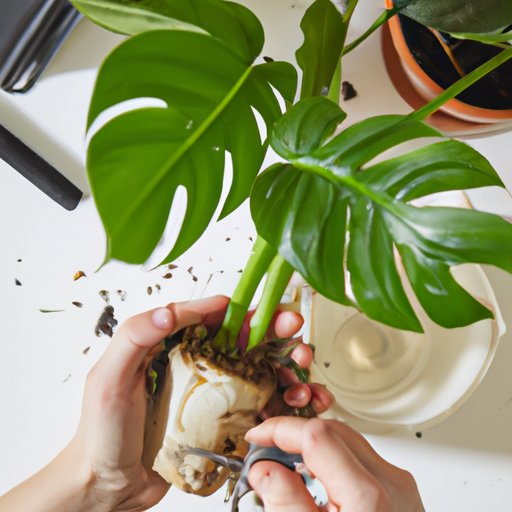Introduction
Monstera is a popular houseplant that has become a staple in many homes and gardens. Native to Central America and Mexico, this plant is known for its unique leaves that resemble Swiss cheese or tropical fruit. While Monstera is relatively easy to care for, it does require some specific conditions to thrive. In this article, we’ll explore how to care for Monstera and provide tips on planting, light, water, and pruning.

Planting and Potting Advice for Monstera Care
When caring for Monstera, the first step is to choose the right pot. To ensure proper drainage, select a pot with several drainage holes at the bottom. Monstera plants prefer to be slightly rootbound, so opt for a pot that is only a few inches larger than the root ball. When it comes to soil, use a well-draining potting mix such as a cactus or succulent mix.
Monstera can also benefit from repotting every two to three years. Before repotting, inspect the roots of the plant and trim off any that appear dry or damaged. When repotting, make sure to use fresh potting soil. After repotting, water the plant thoroughly and allow it to drain completely before placing it back in its original spot.
Understanding the Light, Water, and Soil Requirements of Monstera
Light is an important factor when it comes to caring for Monstera. Place your plant in an area with bright, indirect sunlight or a few hours of direct sunlight each day. If you don’t have access to natural light, consider investing in a grow light to supplement your Monstera’s lighting needs.
When it comes to watering, Monstera plants prefer to be kept evenly moist but should not be overwatered. Water your Monstera about once a week, allowing the top inch of soil to dry out before each watering. To prevent overwatering, make sure your pot has adequate drainage holes.
Finally, Monstera plants prefer soil that is slightly acidic and rich in organic matter. Use a potting mix specifically formulated for Monstera, or create your own by mixing equal parts peat moss, perlite, and compost.

Tips for Pruning and Training Monstera
Pruning Monstera regularly will help keep the plant healthy and encourage new growth. Use sharp, sterilized scissors to remove dead or damaged leaves, as well as any aerial roots that appear above the soil line. Prune away any stems that are growing in an undesirable direction or have become too long.
Monstera can also be trained to climb. To do this, tie the stems to a trellis or other support structure using soft ties or strings. This will help the plant to grow in the desired direction and produce larger leaves.
How to Deal with Pests and Disease in Monstera
Pests and diseases can be a problem when caring for Monstera. To prevent these issues, make sure to inspect your plant regularly for signs of infestation. Common pests include spider mites, mealybugs, and whiteflies. If you do find pests, use an insecticidal soap or neem oil solution to treat them.
In the event of disease, the best course of action is to remove any affected areas and dispose of them safely. Treat the remaining plant with an appropriate fungicide or pesticide. To prevent disease, make sure to avoid overwatering and don’t let your Monstera sit in wet soil for extended periods of time.
Fertilizing and Propagating Monstera
Fertilizing your Monstera is important for keeping it healthy and promoting new growth. Use a balanced fertilizer designed for indoor plants, and apply it according to the instructions on the package. If you don’t want to use a chemical fertilizer, you can also opt for an organic option such as fish emulsion or liquid kelp.
Propagating Monstera is a great way to increase your collection or share the plant with friends. To propagate Monstera, use stem cuttings or air layering. For stem cuttings, cut a section of stem that is at least four inches long and place it in a pot filled with moist potting mix. Air layering involves cutting a section of stem and wrapping it in moist sphagnum moss until it develops roots. Once the roots have developed, the stem can then be planted in a pot filled with moist potting mix.

Troubleshooting Common Problems with Monstera Care
Caring for Monstera can sometimes be challenging, and there are a few common problems that can occur. Overwatering is one of the most common problems, and can lead to root rot and other issues. Make sure to allow the top inch of soil to dry out before each watering, and never let your plant sit in standing water.
Underwatering is another common issue. If your Monstera’s leaves start to turn yellow or brown, this could be a sign of underwatering. Increase your watering frequency and make sure to check the soil moisture before each watering. If the soil feels dry, water your plant.
Issues with soil are also common. Monstera prefers soil that is slightly acidic and rich in organic matter. If your soil isn’t meeting these requirements, consider replacing it with a new potting mix specifically designed for Monstera.
Finally, pests and disease can be a problem when caring for Monstera. Inspect your plant regularly and look out for any signs of infestation or disease. If you do find pests or disease, take the appropriate steps to treat them.
Conclusion
Caring for Monstera doesn’t need to be complicated. With the right pot, soil, light, and water, your Monstera will thrive. Make sure to prune regularly, inspect for pests and disease, and fertilize and propagate when necessary. Following these tips will help ensure your Monstera stays healthy and grows strong.
If you’re still having trouble with your Monstera, there are plenty of resources available online to help. From gardening forums to plant care guides, you’ll be able to find the answers you’re looking for.


